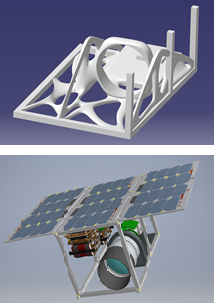The Fraunhofer EMI, IOSB, and INT are currently developing a 12U Nanosatellite (ERNST – Experimental spacecRaft based on NanoSatellite Technology).
The goal of the ERNST-Mission is to evaluate the utility of a nanosatellite mission for scientific and military purposes.
In order to gain an efficient design concept, parts of the satellite structure were developed as an additive design by performing a multi-disciplinary design optimization (numerical optimization).
The optimized, additive structure serves as a mounting for the optical components (camera, filter systems, objective) of the satellite and also as a thermal regulator of the satellite system through an integrated radiator.
The goal of the optimization is to design the satellite structures with mechanical loads (launch phase of the satellite) and thermal loads (solar radiation in orbit) in mind.
Through the symbioses of numerical optimized designs and Additive Manufacturing, an additional benefit is generated in the development phase.
Function integration, reduced weight, maximized performance, and shorter „Design to Part“ development times are only a few benefits.
Publication:
Horch, C. (2017). An MWIR payload with FPGA-based data processing for a 12U nanosatellite. 11th IAA Symposium on Small Satellites for Earth Observation
Link:
Contact:
Fraunhofer EMI, Marius Bierdel, marius.bierdel@emi.fraunhofer.de, +49 761 2714 440
